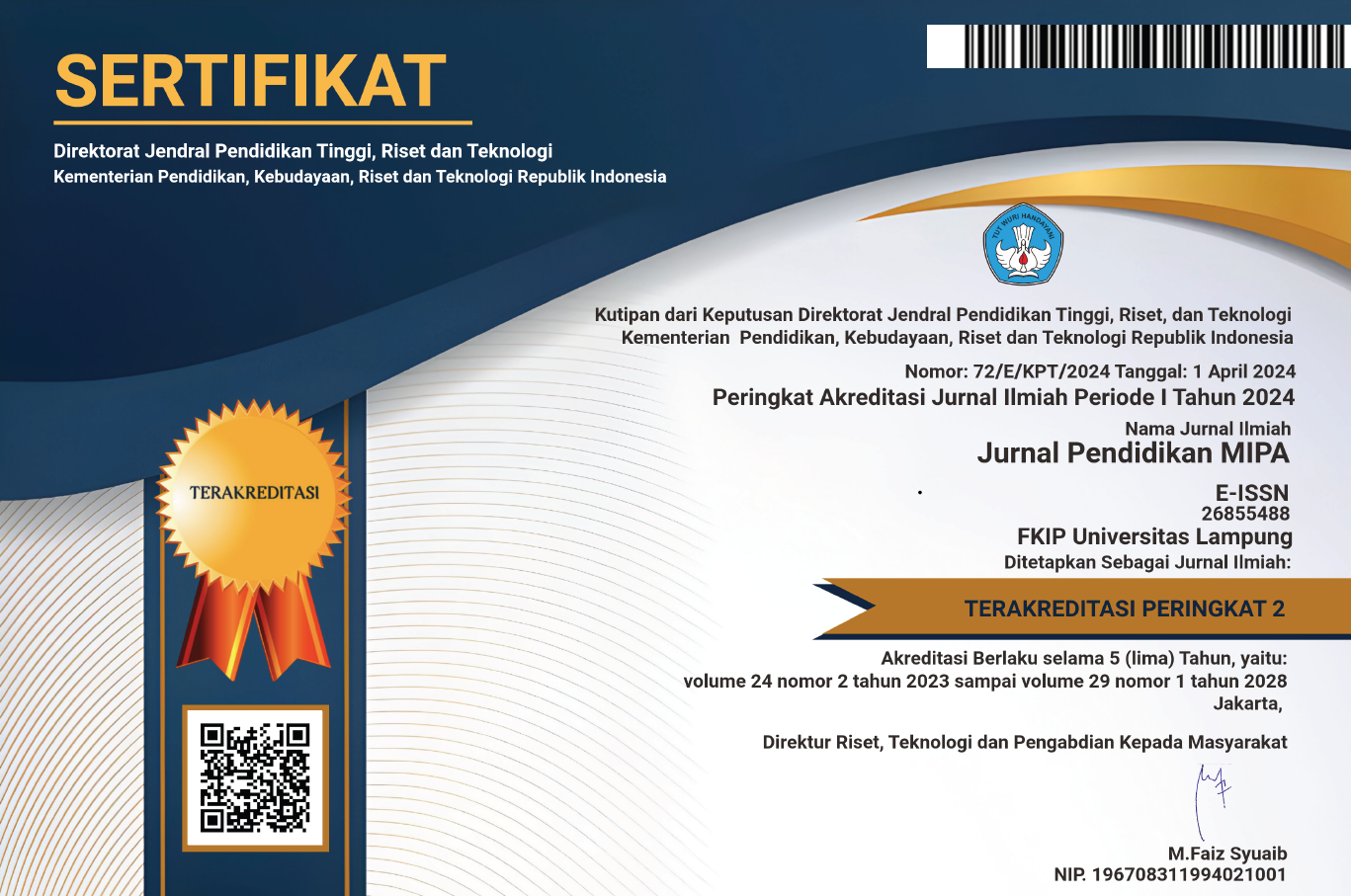Development of Science Literacy-Based Physics e-Module in Kinematics Motion
 Country:
Country:
(1) Universitas Negeri Surabaya, Indonesia
(2) Universitas Negeri Surabaya, Indonesia
(3) Universitas Negeri Surabaya, Indonesia
(4) Universitas Negeri Surabaya, Indonesia
The purpose of this study is to describe the feasibility of the e-Module Based on Science Literacy (e-MLIST) in the Basic Physics course on the topic motion kinematics. The eMLIST media could be the answer to the paradigm shift in the world of education during COVID-19. This study applied research and development with the Decide, Design, Develop, and Evaluate (DDDE) model to create the electronic modules. The e-MLIST has several advantages, such as the Module being electronic-based, which offers flexible utility. It means eMILST can be used whenever and wherever it is located. The e-MILST could be used to train students' scientific literacy skills in Basic Physics One lecture on motion kinematics. In this case, e- MILST will be used as a source of learning and teaching materials in the Basic Physics One course, whether offline, online or hybrid. The analysis results show that the e-MLIST is very valid, with 91.69% validity, The practicality of using e-MLIST in basic physics lectures 1 motion kinematics material is 87.13% with excellent criteria and The effectiveness of the use of e-MLIST in basic physics lectures 1 motion kinematics material is seen from the improvement of students' science literacy skills by n-gain 0.57 with moderate criteria. This means that eMILST is worthy of being used as a learning media in basic physics lectures 1 topic of motion kinematics.
Keywords: e-module, science literacy, physics learning.
Ananiadou, K., & Claro, M. (2009). 21st century skills and competences for new millennium learners in OECD countries. OECD Education Working Papers, (41), 33. http://dx.doi.org/10.1787/218525261154
Kusumawati, A. T., Wasis, Sanjaya, I. G. M., & Kholiq, A. (2020). Elite (e-book literacy) for junior high school student’s scientific literacy in solar system material. Journal of Physics: Conference Series, 1491(1). https://doi.org/10.1088/1742-6596/1491/1/012070
Brookhart, S. M. (2010). How to assess higher order thinking skills in your classroom. Virginia: ASCD.
Fitriani, W., Hairida, & Lestari, I. (2014). Deskripsi literasi sains siswa dalam model inkuiri pada materi laju reaksi di SMAN 9 Pontianak [Description of students' scientific literacy in inquiry model on reaction rate material at SMAN 9 Pontianak]. Jurnal Pendidikan Dan Pembelajaran, 3(1), 12.
International Council of Association for Science Education (ICASE). (2008). http://www.icaseonline.net
Gueval, J., Tarnow, K., & Kumm, S. (2015). Implementing e-books: Faculty and student experiences. Teaching and Learning in Nursing, 10(4), 181–185. https://doi.org/10.1016/j.teln.2015.06.003
Haristy, D. R., Enawaty, E., & Lestari, I. (2014). Pembelajaran berbasis literasi sains pada materi larutan elektrolit dan non elektrolit di SMA Negeri 1 Pontianak [Scientific literacy-based learning on electrolyte and non-electrolyte solutions at SMA Negeri 1 Pontianak]. Jurnal Pendidikan Dan Pembelajaran, 2(12), 27–36.
Irma, Z. U., & Kustijono, R. (2017). Development of android mobile learning using app inventor to train high school student’s science process skill. Inovasi Pendidikan Fisika, 6(3), 224–230.
Jaknov, T. P. (2008). Metode penelitian pengembangan [Development research method].
Kemdikbud. (2017). National literacy movement guide. Jakarta: Kemdikbud.
Kustijono, R., & Zuhri, F. (2018). The use of Facebook and WhatsApp application in learning process of physics to train students’ critical thinking skills. IOP Conference Series: Materials Science and Engineering, 296(1). https://doi.org/10.1088/1757-899X/296/1/012025
Liliasari & Fitriana. (2014). Persiapan literasi sains generasi muda Indonesia menjelang Asean Community [Preparation of science literacy for Indonesia's younger generation towards the Asean Community]. Paper presented at the 2014 Unesa National Seminar.
Martiono, K. T., & Nurhayati, O. D. (2014). Implementation of android-based mobile learning application as a flexible learning media. International Journal of Computer Science Issues, 11(3), 168–174.
OECD. (2019). PISA. Paris: OECD Publishing.
OECD. (2017). PISA. Paris: OECD Publishing.
Ravenscroft, A., Warburton, S., Hatzipanagos, S., & Conole, G. (2012). Designing and evaluating social media for learning: shaping social networking into social learning? Journal of Computer Assisted Learning, 28(3), 177–182. https://doi.org/10.1111/j.1365-2729.2012.00484.x
Riduwan. (2015). Skala pengukuran variabel-variabel penelitian [Measurement scale of research variables]. Bandung: Alfa Beta.
Serway, R. A., & Jewett, J. W. (2004). Physics for Scientist and Engineers (6th ed.). California: Thomson Brooks/Cole.
Shidiq, A. S., Masykuri, M., & Hayus, E. S. V. (2014). Pengembangan instrumen penilaian two-tier multiple choice untuk mengukur keterampilan berpikir tingkat tinggi (higher order thinking skills) pada materi kelarutan dan hasil kali kelarutan untuk siswa SMA/MA kelas XI [Development of a two-tier multiple choice assessment instrument to measure higher order thinking skills in solubility material and solubility product for students in class XI SMA/MA]. Jurnal Pendidikan Kimia, 3(4), 83–92.
Sudarisman, S. (2015). Memahami hakikat dan karakteristik pembelajaran biologi dalam upaya menjawab tantangan abad 21 serta optimalisasi implementasi kurikulum 2013 [Understand the essence and characteristics of biology learning in an effort to answer the challenges of the 21st century and optimize the implementation of the curriculum 2013]. Florea: Jurnal Biologi dan Pembelajarannya, 2(1), 29–35. https://doi.org/10.25273/florea.v2i1.403
Sugiyono. (2019). Metode penelitian pendidikan [Educational research methods]. Bandung: Alfabeta.
Tegeh, I. M., & Kirna, I. M. (2012). Metode penelitian pengembangan pendidikan [Educational development research methods]. Singaraja: Graha Ilmu.
Trilling, B., & Fadel, C. (2009). 21st century skills: Learning for life in our times. Hoboken: Jossey-Bass/Wiley.
Trisdiono, H. (2013). Lembaga penjaminan mutu pendidikan propinsi D.I. Yogyakarta [Yogyakarta Provincial Education Quality Assurance Institute].
Wasis, Rahayu, Y. S., Sunarti, T., & Indana, S. (2020). HOTS dan Literasi Sains: Konsep, Pembelajaran dan Penilaiannya [HOTS and Science Literacy: Concepts, Learning and Assessment]. Jombang: Kun Fayakun.
Yager, R. E. (2000). A vision for what science education should be like for the first 25 years of a new millennium. School Science and Mathematics, 100(6), 327–341. https://doi.org/10.1111/j.1949-8594.2000.tb17327.x
Refbacks
- There are currently no refbacks.

This work is licensed under a Creative Commons Attribution-ShareAlike 4.0 International License.






